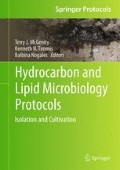Abstract
In the following chapter, we discuss the role of two-phase substrate transfer and partitioning for substrate bioavailability. We describe four different two-phase cultivation techniques, which aim at controlling growth-limiting substrate mass transfer rates (Protocols 1 and 2) and/or at decreasing the toxicity of substrates (Protocols 3 and 4).
Access this chapter
Tax calculation will be finalised at checkout
Purchases are for personal use only
References
Wodzinski RS, Coyle JE (1974) Physical state of phenanthrene for utilization by bacteria. Appl Microbiol 27:1081–1084
Harms H, Bosma TNP (1997) Mass transfer limitation of microbial growth and pollutant degradation. J Ind Microbiol Biotechnol 18:97–105
Daugulis AJ (2001) Two-phase partitioning bioreactors: a new technology platform for destroying xenobiotics. Trends Biotechnol 19:457–462
Bosma TNP, Middeldorp PJM, Schraa G, Zehnder AJB (1997) Mass transfer limitation of biotransformation: quantifying bioavailability. Environ Sci Technol 31:248–252
Wick LY, Colangelo T, Harms H (2001) Kinetics of mass transfer-limited bacterial growth on solid PAHs. Environ Sci Technol 35:354–361
Janssen PH, Yates PS, Grinton BE, Taylor PM, Sait M (2002) Improved culturability of soil bacteria and isolation in pure culture of novel members of the divisions Acidobacteria, Actinobacteria, Proteobacteria, and Verrucomicrobia. Appl Environ Microbiol 68:2391–2396
Zengler K, Toledo G, Rappe M, Elkins J, Mathur EJ, Short JM, Keller M (2002) Cultivating the uncultured. PNAS 99:15681–15686
Schwarzenbach RP, Gschwend PM, Imboden DM (2003) Environmental organic chemistry, 1st edn. Wiley, Hoboken
Reichenberg F, Mayer P (2006) Two complementary sides of bioavailability: accessibility and chemical activity of organic contaminants in sediments and soils. Environ Toxicol Chem 25:1239–1245
Rijnaarts HHM, Bachmann A, Jumelet JC, Zehnder AJB (1990) Effect of desorption and intraparticle mass transfer on the aerobic biomineralization of a-hexachlorocyclohexane in a contaminated calcareous soil. Environ Sci Technol 24:1349–1354
Wick LY, deMunain AR, Springael D, Harms H (2002) Responses of Mycobacterium sp. LB501T to the low bioavailability of solid anthracene. Appl Microbiol Biotechnol 58:378–385
Hanzel J, Thullner M, Harms H, Wick LY (2011) Microbial growth with vapor-phase substrate. Environ Pollut 159:858–864
Hanzel J, Thullner M, Harms H, Wick LY (2012) Walking the tightrope of bioavailability: growth dynamics of PAH degraders on vapour-phase PAH. J Microbial Biotechnol 5:79–86
Mayer P, Wernsing J, Tolls J, de Maagd PGJ, Sijm DTHM (1999) Establishing and controlling dissolved concentrations of hydrophobic organics by partitioning from a solid phase. Environ Sci Technol 33:2284–2290
Smith KEC, Oostingh GJ, Mayer P (2010) Passive dosing for producing defined and constant exposure of hydrophobic organic compounds during in vitro toxicity tests. Chem Res Toxicol 23:55–65
Smith KE, Rein A, Trapp S, Mayer P, Karlson UG (2012) Dynamic passive dosing for studying the biotransformation of hydrophobic organic chemicals: microbial degradation as an example. Environ Sci Technol 46:4852–4860
Holliger C, Schraa G, Stams AJM, Zehnder AJB (1993) A highly purified bacterium couples growth to the reductive dechlorination of tetrachloroethene to cis-1,2-dichloroethene. Appl Environ Microbiol 59:2991–2997
Holliger C, Schraa G, Stams AJM, Zehnder AJB (1992) Enrichment and properties of an anaerobic mixed culture reductively dechlorinating 1,2,3-trichlorobenzene to 1,3-dichlorobenzene. Appl Environ Microbiol 58:1636–1644
Reineke W, Knackmuss H-J (1984) Microbial metabolism of haloaromatics: isolation and properties of a chlorobenzene-degrading bacterium. Appl Environ Microbiol 47:395–402
Spain JC, Nishino SF (1987) Degradation of 1,4-Dichlorobenzene by a Pseudomonas sp. Appl Envrion Microbiol 53:1010–1019
Haigler BE, Nishino SF, Spain JC (1988) Degradation of 1,2-dichlorobenzene by a Pseudomonas sp. Appl Environ Microbiol 54:294–301
Dorn E, Hellwig M, Reineke W, Knackmuss H-J (1974) Isolation and characterization of a 3-chlorobenzoate degrading pseudomonad. Arch Microbiol 99:61–70
van Uden N (1967) Transport-limited growth in the chemostat and its competitive Inhibition; a theoretical treatment. Arch Microbiol 58:145–154
Rusina TP, Smedes F, Klanova J, Booij K, Holoubek I (2007) Polymer selection for passive sampling: a comparison of critical properties. Chemosphere 68:1344–1351
Smith KEC, Dom N, Blust R, Mayer P (2010) Controlling and maintaining exposure of hydrophobic organic compounds in aquatic toxicity tests by passive dosing. Aquat Toxicol 98:15–24
ter Laak TL, Busser FJM, Hermens JLM (2008) Poly(dimethylsiloxane) as passive sampler material for hydrophobic chemicals: effect of chemical properties and sampler characteristics on partitioning and equilibration times. Anal Chem 80:3859–3866
Author information
Authors and Affiliations
Corresponding author
Editor information
Editors and Affiliations
Rights and permissions
Copyright information
© 2015 Springer-Verlag Berlin Heidelberg
About this protocol
Cite this protocol
Wick, L.Y., Otto, S., Holliger, C. (2015). Two-Phase Cultivation Techniques for Hydrocarbon-Degrading Microorganisms. In: McGenity, T., Timmis, K., Nogales , B. (eds) Hydrocarbon and Lipid Microbiology Protocols. Springer Protocols Handbooks. Springer, Berlin, Heidelberg. https://doi.org/10.1007/8623_2015_124
Download citation
DOI: https://doi.org/10.1007/8623_2015_124
Published:
Publisher Name: Springer, Berlin, Heidelberg
Print ISBN: 978-3-662-45178-6
Online ISBN: 978-3-662-45179-3
eBook Packages: Springer Protocols

